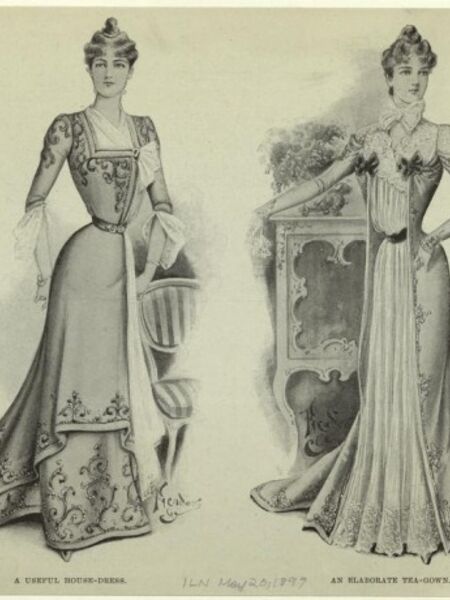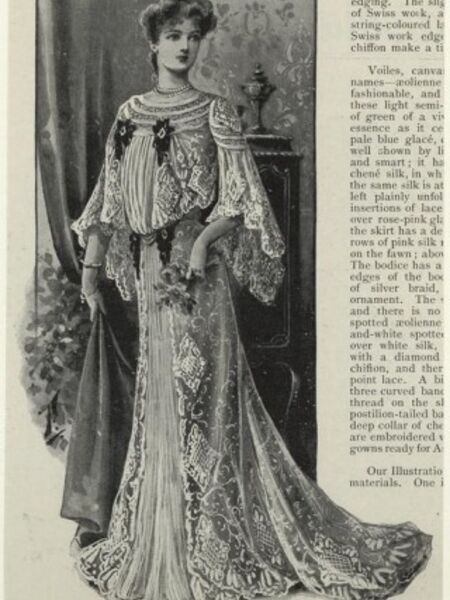Tea Fashions Echo Women’s Liberation


Shortly after Anna Maria Russell, Duchess of Bedford began the tradition of “a little something” with tea, to stave off hunger between lunch and a late supper, the court of Queen Victoria adopted the idea. A lifelong friend of the queen, Anna served as her lady of the bedchamber between 1837 and 1841, but had little influence in changing the queen’s dour black-dress habit following the death of her beloved Prince Albert. Nonetheless, the Duchess and other ladies of the courts were keen to turn to their seamstresses to create something suitable for what soon became the more elaborate and delicious repast of Afternoon Tea.
TEA GOWNS OFFER COMFORT WITH FASHION
My lady has a tea-gown
That is wondrous fair to see,
It is flounced and ruffed and plaited and puffed,
As a tea-gown ought to be.
-Anonymous
The result was a dressing gown which debuted a few decades later. It was part wrapper (an elegant bathrobe, worn without a corset,) and part ball gown with all its requisite luxurious details complete with train and flowing diaphanous sleeves. This free-flowing gown skimmed over the waist and its typical high-neck differentiated from the more bodice-baring evening gown.
Because they were easy to slip on, the gowns had the added boon of not requiring a maid to help the women dress, perhaps encouraging some women to enthusiastically welcome the occasional but unexpected guest, especially males. A group of “dress reformers” hailed the tea gown for its comfort but dissenters thought them scandalous, especially when worn in the company of men not the husband of the hostess.
Although made with the extravagance of ball gown fabrics including hand-made laces, silks, and brocades, many women wore them both for tea in the afternoon, alone or with guests, and for supper with their family and introduced a generation of women to the idea that they could be both fashionable and comfortable.
Soon, these same women were wearing their tea gowns out of the house to visit friends, traveling in public where everyone could see them, though to be sure, catching sight of a lady’s ankle was as wild as this fashion offered in the late 19th century.
KICKING UP HER HEELS AT THE TEA DANCE
Beginning in the 1920s, the voluptuous cinched-waist and full buttocks look gave way to the boyish body profile with (egads!) sleeveless dresses that skimmed the waist or dropped it toward the hips, and hemlines were lifted from floor length first to mid-calf then to just below the knees. For night time, sequins replaced lace, and the choker or discreet brooch ceded to ropes of necklaces that reached the waist, elongating the overall look.
Gone were restrictive undergarments and “Gibson Girl” hairstyles contrived to control mounds of shoulder-length hair. Cloche hats accented the shorter hairdos and women embraced such social behavior as cigarette smoking, daytime champagne drinking, and socializing during the late afternoon that could lead to assignations at night!
None of the afternoon socializing was more popular than the tea dance which began in France as thé dansant and usually held from 4 to 7 p.m. from summer to fall. In England, it was the highlight following a garden party and in the U.S. it was any afternoon dance and quite casual.
While it is true that military ships and posts were the scenes of many tea dances during the Victorian era, these were not court-sanctioned experiences but popular as a way for officers to entertain with a certain upper-echelon style. Guests would be served typical English tea fare including scones or crumpets, tiny finger sandwiches of cucumber, salmon or egg salad, followed by petit fours or small slices of cakes, a far cry from the hot buttered toast of Anna’s era. Teas would include a classic black Assam, perhaps a Fujian oolong, and for those with more delicate tastes, a soothing chamomile.
Men, at least gay men, were liberated as well, and tea dances were held throughout major cities where it was possible for them to socialize, dance, and meet others during an era when such behavior was illegal in some areas and frowned upon in others.
As the Charleston and other exuberant dances became more popular, hemlines rose to accommodate their kicking style, and for both men and women, the exotic, precise steps of the tango was reason to dress up, go out, and enjoy tea, or whiskey, in your cup. Sunday afternoon tea dances were often the highlight of the week whether at a fine hotel like the Ritz or an atrium in an elegant manse hosted by wealthy friends. Orchestras or small bands played the music live, a banquet of fine sandwiches, scones, and sweets were at the ready, and sparkling champagne and strong liquors were served alongside silver urns of the finest teas from India and China.
By the 1930s, fashion had changed once more. Waists were back, hips and bosoms were accented, and although hairstyles still remained relatively short, curls became a hairdresser’s annuity.
FOR TEA DANCES TODAY, GO VINTAGE
The tea length dress remains enormously popular as a perennial of perfection for weddings, ladies’ luncheons, and afternoon tea. Always hemmed between the ankle and the knee, they’re the epitome of feminine allure in pretty pastels or delicate prints, soft chiffon or crisp piques, often accented with the pure fun of a fascinator or hat.
Fascinators are attached to the hair with a headband or hair clip and never removed when one is at tea. While gloves are no longer the venerable fashion statement, if you cannot resist, remove them prior to eating and place them on your lap, never on the table. For further discretion, and protection, cover them with your napkin. Simple jewelry is fine, and a choker of pearls is almost a proverb, but leave the dangling charm bracelets at home as they could inadvertently dip into the clotted cream or crock of marmalade.
Fashion today is blessedly without the restrictions of previous eras, or their many rules spoken or written. And, choosing an era, especially vintage, really amps up the fun for today’s tea dance events. So sort that playlist on your iTunes or break out the old iPod, and consider period dress from the 1940s for swing dancing to Glenn Miller or Benny Goodman; flats and poodle skirts for 1950s rock’n roll with Chuck Berry or Fats Domino, or find someone’s old turntable and records to dance to a Charleston or a Joplin rag.
Consider a menu to match the vintage era of your clothes. Onion dip and potato chips and meatloaf sandwiches served with mango iced tea for the 1960s; hot English Breakfast, a fruit-laden Jell-o mold, and chicken salad for 1950s or egg salad, salmon croquets, and apple pie for the 1940s. Or, ask your grandparents to take a trip down memory lane and share what they ate before or after dances and tea parties.
Have a blast!
Images from The Dreamstress Article on Tea Gowns.
